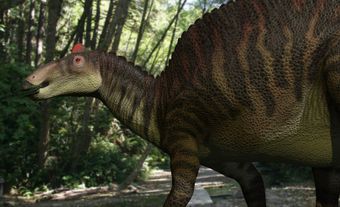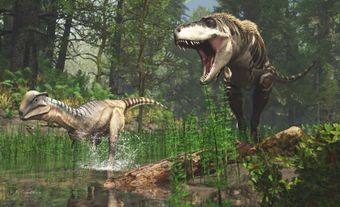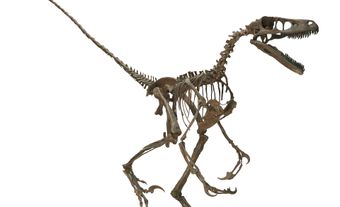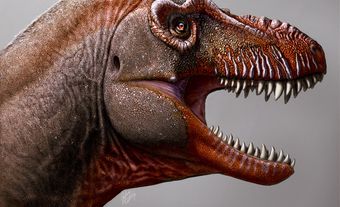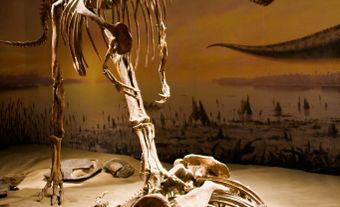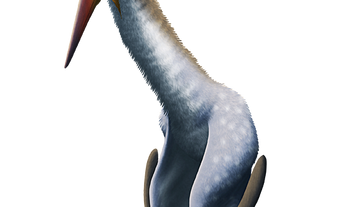Lambeosaurus is a genus of large, plant-eating, duckbilled dinosaur. There are three known species of Lambeosaurus, all found in southern Alberta: L. clavinitialis, L. lambei and L. magnicristatus. In 1913, fossil collector Charles H. Sternberg discovered the first Lambeosaurus fossils in the modern-day Dinosaur Provincial Park area. A year later, Canadian paleontologist Lawrence Lambe named the fossils Stephanosaurus marginatus. Fellow Canadian William Parks then renamed the species Lambeosaurus lambei in 1923 in honour of Lambe. (See also Dinosaurs Found in Canada.)
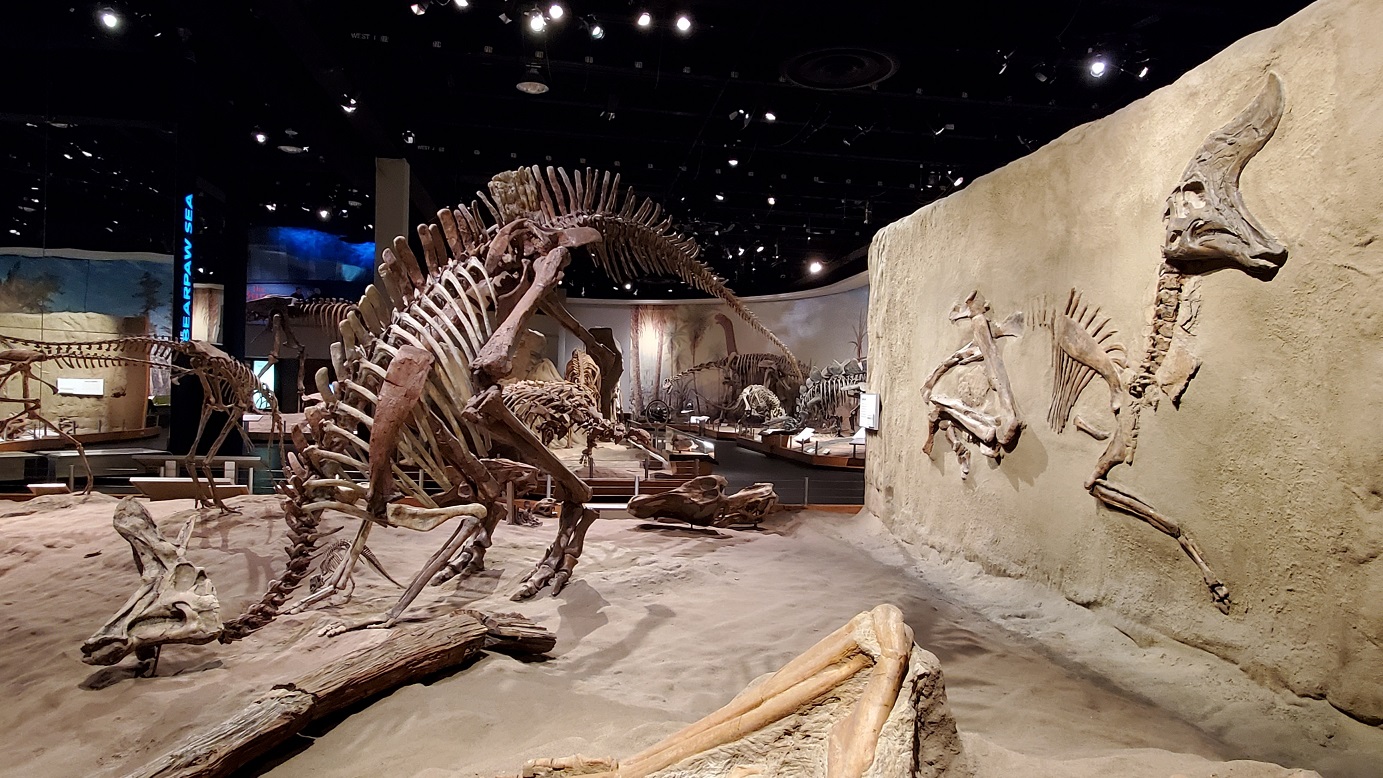
Description
Despite being 7–9 m long and weighing 2.5–3.3 tonnes, Lambeosaurus was averaged-sized for a hadrosaur (or duckbilled dinosaur). It had powerful hind limbs, shorter forelimbs, a long, muscular tail and a large head perched at the end of a short neck. Its feet had three toes and its hands four fingers. Three of these fingers were wrapped together in a fleshy “mitten.” The last finger (the pinky) was isolated and capable of grasping like a thumb. This “mitten” strengthened the hand to support the weight of the animal when it walked on four legs, although Lambeosaurus could rear up on two legs to feed on trees.
Lambeosaurus belongs to the subfamily Lambeosaurinae. The Lambeosaurinae were a group of hadrosaurs that had a large, hollow, bony crest of various shapes on their head. Paleontologists recognize three species of Lambeosaurus: L. clavinitialis, L. lambei and L. magnicristatus. L. clavinitialis and L. lambei had a crest shaped like a hatchet, with the “blade” projecting forward and upward, and the “handle,” which looked like a short rod, projecting backward. The crest of L. clavinitialis was slightly shorter and more rounded than that of L. lambei. The crest of the third species, L. magnicristatus, consisted of a larger blade projecting forward and no backward rod. The animal’s nasal airways traveled from the nostrils through its crest to the throat. Paleontologists believe lambeosaurines used their crest both for display and as a resonating chamber. The resonating chamber would amplify their calls in order to communicate with members of their species and to attract mates.
Like all hadrosaurs, Lambeosaurus had a duck-like, bony snout covered by a beak. Inside their mouths were hundreds of closely packed teeth. When the upper teeth came in contact with the lower teeth, both wore down to form a tooth pavement. Different parts of this “pavement” were harder than others, making it ideal for grinding plant matter.
Lambeosaurus was covered with uniform polygonal scales 5 mm in diameter. The scales covered most of the body and became slightly larger on the tail. Interspersed among these polygonal scales were subcircular arrangements of larger, wedge-shaped scales (12 mm in diameter). The colour of the skin is unknown.
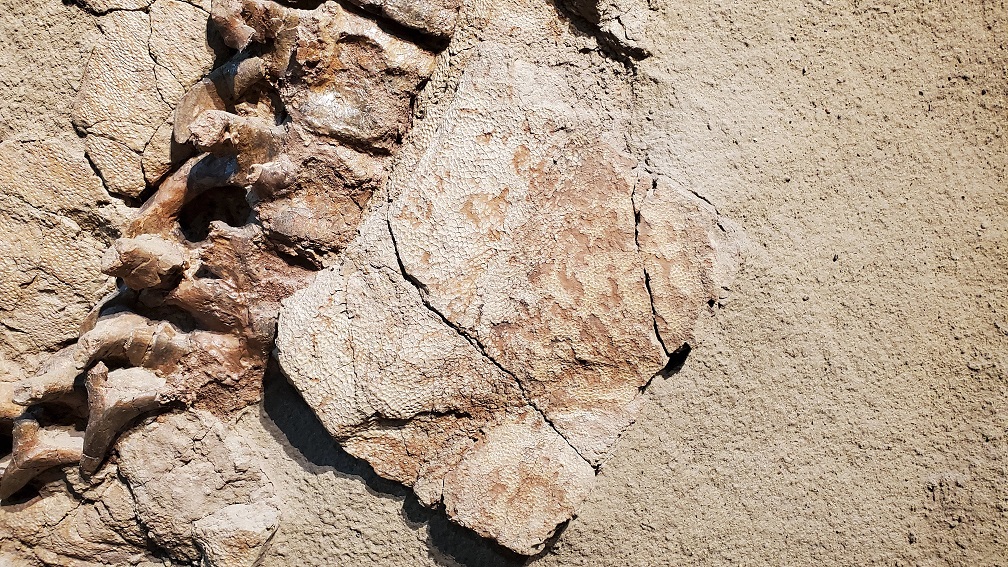
Range and Habitat
Fossil remains attributable to all three species of Lambeosaurus are found in the Dinosaur Park Formation of southern Alberta. They inhabited the subtropical western coastal plain of the Western Interior Seaway, an inland sea that connected the modern-day Arctic Ocean to the Gulf of Mexico, dividing North America in two. Lambeosaurus lived during a time when sea levels were rising and the shoreline of the Western Interior Seaway was moving westward from modern-day Saskatchewan. However, the three Lambeosaurus species did not live together. Rather, they succeeded one another through time: L. clavinitialis lived between 76.1 and 75.9 million years ago, L. lambei between 76 and 75.5 million years ago and L. magnicristatus 75.3 million years ago. Paleontologists have two hypotheses to explain this succession of species. First, one species may have rapidly evolved into a new one. Alternatively, the three Lambeosaurus species lived at the same time but occupied different habitats on the coastal plain. The westward movement of the Western Interior Seaway caused habitats and animals to move west. With time, one Lambeosaurus species replaced another in the modern-day Dinosaur Provincial Park area as the Western Interior Seaway neared.
Reproduction and Development
Even though paleontologists have not identified Lambeosaurus eggs, it is presumed to have laid clutches similar to the closely related lambeosaurine Hypacrosaurus stebingeri. The clutches consisted of more than 20 spherical eggs, about 20 cm in diameter. They were buried under a mound of vegetation for incubation, similar to the nests of crocodiles. The eggs took 82 days to hatch and the hatchlings measured approximately 60 cm in length.
Young Lambeosaurus individuals did not have a crest. The crest grew gradually as the animal aged, probably in response to puberty. Interestingly, young lambeosaurines of different species all had very similar rounded crests, such that it is difficult to determine to which species they belonged. It is only with age that the crests took on the shape diagnostic of their respective species.
Diet
Lambeosaurus was herbivorous. Like most ornithischian dinosaurs, Lambeosaurus’s teeth were inside its mouth, as opposed to on the edge as seen in crocodiles. The position of its teeth indicates that either fleshy cheeks or jaw muscles helped keep food in the mouth while chewing. The beak allowed Lambeosaurus to crop food from plants and trees. Hadrosaurs could not chew by moving their lower jaws from side-to-side like mammals. Instead, the lower jawbone rotated inward, allowing the upper teeth to grind against the lower teeth to pulverize plant matter, similar to its distant cousin Edmontosaurus.
Behaviour
Nothing is known about the social behaviour of Lambeosaurus. However, the fact that it had a crest that could be used for display, communication and to attract mates suggests that it was somewhat gregarious. Paleontologists have discovered bonebeds and tracksites for numerous hadrosaur species, which indicate that these animals lived in herds of tens to hundreds of individuals.
Discovery
In the late 1890s and early 1900s, Canadian paleontologist Lawrence Lambe discovered a variety of separate hadrosaur bones in the area of modern-day Dinosaur Provincial Park. He attributed these bones to a single species and gave it the name Trachodon marginatus in 1902. In 1913, fossil collector Charles H. Sternberg discovered three hadrosaur skeletons, including two partial skulls, in the same area. Lambe believed Sternberg’s discoveries belonged to Trachodon marginatus but decided to create a new genus because of the new fossils’ distinctive crest shape. He named both his and Sternberg’s fossils Stephanosaurus marginatus. In 1914, American paleontologist Barnum Brown criticized Lambe’s decision, arguing that the 1902 specimens were too incomplete to know with certainty that the new skulls belonged to the same species. In 1923, Canadian paleontologist William Parks reluctantly sided with Brown. He named the crested hadrosaur Lambeosaurus lambei in honour of Lambe, who had died in 1919. To this day, it is unclear to which hadrosaur species the bones Lambe originally discovered at the turn of the 20th century actually belong.
During the first half of the 20th century, paleontologists discovered numerous lambeosaurine skulls with crests of various sizes and shapes in Dinosaur Provincial Park. Each type was given its own genus and species names. In 1975, paleontologist Peter Dodson conducted a study that revealed that specimens with a poorly developed crest were in fact juvenile Lambeosaurus individuals. He also concluded that some specimens with smaller crests, like Lambeosaurus clavinitialis, represented female individuals, whereas specimens with larger crests, like Lambeosaurus lambei, represented male individuals. As such, he believed that only two Lambeosaurus species were valid: L. lambei and L. magnicristatus. However, later studies revealed that L. lambei specimens considered “male” and “female” occurred at different stratigraphic levels within the Dinosaur Park Formation and hence would have lived at different time periods. This discovery disproved the idea that the various crest shapes represented sexual differences and confirmed that Lambeosaurus clavinitialis was a distinct species.

 Share on Facebook
Share on Facebook Share on X
Share on X Share by Email
Share by Email Share on Google Classroom
Share on Google Classroom
